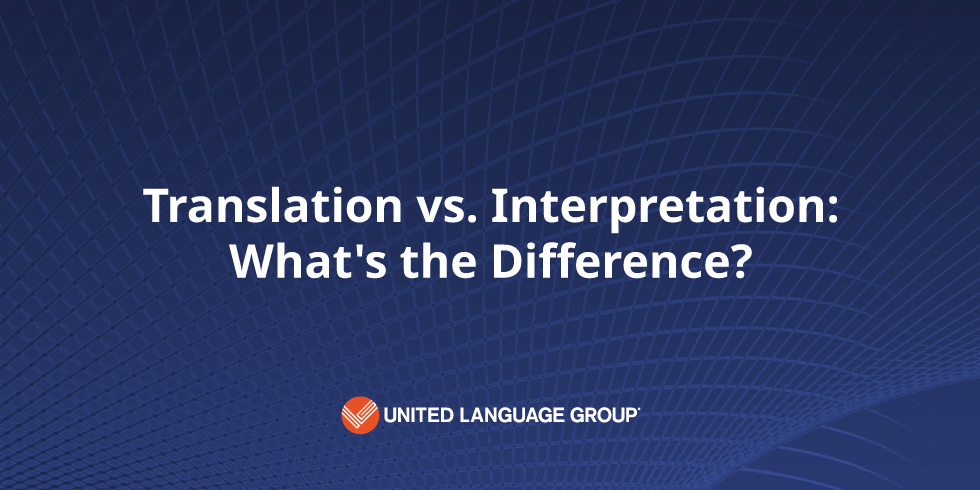In a world where almost 68 million people in the U.S. speak a language other than English at home, the real challenge isn't deciding if language access services are necessary but figuring out which services to offer and the best way to deliver them.
Translation and interpretation are terms often thought to be the same, but they are different disciplines with different use cases and considerations. To transcend language barriers effectively, choosing the right service at the right time is a must. This guide will help you understand the difference between the two so you can better serve your growing multilingual community.
Interpretation Versus Translation
You may have used the terms “interpretation” and “translation” interchangeably before, perhaps saying “I need a translator,” when you really meant, “I need an interpreter.” So, what’s the difference between translation and interpretation?
At the highest level, it comes down to the medium of communication: translation involves written communication while interpreting involves spoken or signed language. They’re related, because both deal with transferring communication from one language to another, but they aren’t the same. They both require deep linguistic expertise, but the two professions use that expertise in different ways. And make no mistake, they are two separate professions: linguists usually specialize in one discipline or another.
Let’s take a closer look at the differences between these services, and how to select the best options for your organization.
What is Translation?
When we think of overcoming language barriers, speaking and oral communication often comes to mind. But what about written communication? That’s where translation comes into the picture.
In language, translation refers to converting the written word from one language to another. This work requires not just fluency in both source and target languages but also the ability to understand and convey complex concepts, figures of speech, and subtleties that are specific to each language.
For example, consider the Japanese proverb '猿も木から落ちる' (Saru mo ki kara ochiru), which directly translates to 'Even monkeys fall from trees.' Translating it word for word into English could be confusing. Translating it as “Nobody’s perfect” or “Everyone makes mistakes” makes the meaning clear.
Translation projects can take a long time: the timeframe for translation can vary significantly from one project to another, depending on the length, technology used, complexity of the text, and the need for research or subject matter expertise. Translators often spend hours to weeks crafting their translations for accuracy and readability.
To speed up the process and improve accuracy, translators use specialized software, dictionaries and resources for research. Translation Memory (TM) tools and Computer-Assisted Translation (CAT) software help translators work more efficiently and ensure consistency across large projects.
Translators handle a wide array of content, from technical manuals and legal documents to websites, books, and subtitles for films. The goal is to produce a document that reads as if it was originally written in the target language, which demands a deep understanding of both the subject matter and the cultural preferences of the audience.
There are several different types of professional translation services available:
- Human Translation: Purely human-powered translation is still the gold standard for accuracy, cultural sensitivity, and nuance. It's essential for high-stakes or highly specialized content where accuracy is crucial.
- Machine Translation (MT): This is the automatic translation of text by computer software without human intervention. It's fast and cost-effective but may lack accuracy and cultural relevance for complex texts.
- Machine Translation Post-Editing (MTPE): This process involves human translators reviewing and correcting machine-generated translations. It strikes a balance between the speed of MT and the accuracy of human translation.
Each method has its place, depending on the needs of the project, including the required level of accuracy, the content's sensitivity, and the available budget. Understanding these differences is key to choosing the right translation service for your written content needs.
What Is Interpretation?
Interpreters help people who speak different languages communicate in person, via the phone, or through technology, like video, in situations such as emergency medical calls to business transactions, where clear and precise oral communication is vital.
To achieve this, interpreters need to be able to think on their feet and move between languages quickly and effortlessly.
Interpreters can work on-site, or they can work remotely. On-site interpreting requires no special equipment, but it does require that an interpreter be in the area and available for the required language, and that means planning ahead.
When that’s not practical, technology offers options for instant connection:
- Over-the-Phone Interpreting (OPI): Offers flexibility and immediacy for situations where visual cues aren’t necessary. The only requirement is a telephone, making it a go-to for quick or unplanned exchanges.
- Video Remote Interpreting (VRI): Combines the immediacy of phone interpreting with the added benefit of visual cues, using a screen, camera, and internet connection. Perfect for contexts where facial expressions and gestures matter but on-site interpreting isn’t feasible.
- Remote Simultaneous Interpreting (RSI): With Remote Simultaneous Interpreting (RSI), interpreters translate spoken content into another language in real-time. Headsets allow everyone involved to hear the conversation in their own language without delay.
OPI is typically consecutive, which means that the speaker pauses to allow the interpreter to interpret what they’ve said. On-site interpretation and VRI can be either consecutive or simultaneous.
For interpreting, you’ll need a team that can handle the most prevalent languages spoken by your target audience. For example, some metropolitan areas require proficiency in dozens– if not hundreds – of major languages.
Additionally, for unpredictable and often urgent situations like healthcare, interpreters should be available 24 hours a day, 7 days a week for over-the-phone, video-remote, and in-person services.
Summarizing the Key Differences Between Language Interpretation and Translation
Translation and interpretation help everyone understand each other, but they do it in different ways. Here's a breakdown:
- Medium: Translation is for written words, turning text from one language into another. Interpretation is all about spoken or signed languages, helping people communicate in real time.
- Skills Needed: Translators focus on getting written messages just right. They need research skills, a rich vocabulary, strong understanding of both the original and target culture and a knack for choosing just the right word. Interpreters need to think fast to keep conversations flowing smoothly across different languages.
- Tools: Translators use special software to work faster and keep things consistent. Interpreters might use phone or video technology to help people talk to each other, even if they're far apart.
- When to Use Them: Use translation for things like documents and websites to make sure they make sense in another language. Choose interpretation when you need to talk to someone right away, like in meetings or emergencies.
Bridge the Language Gap
Offering the right mix of translation and interpretation services is essential in today’s multilingual world. Our team is here to guide you through selecting the perfect blend to meet your needs. Whether you need professional translation services, professional interpretation services, or a mix of both, we've got you covered.



